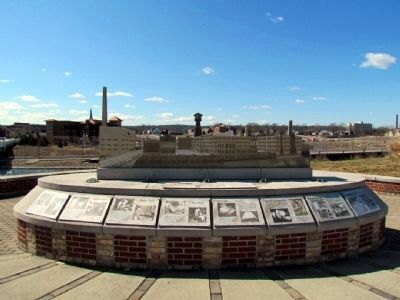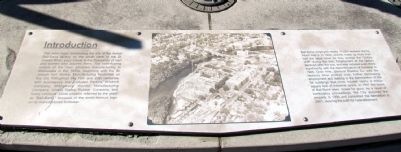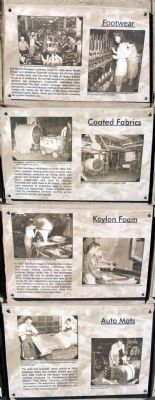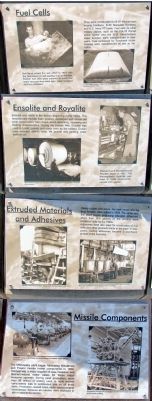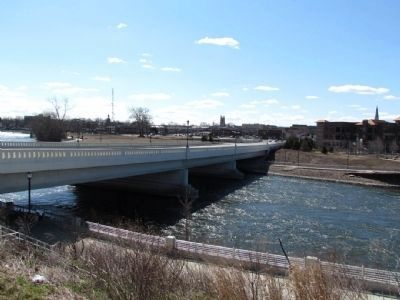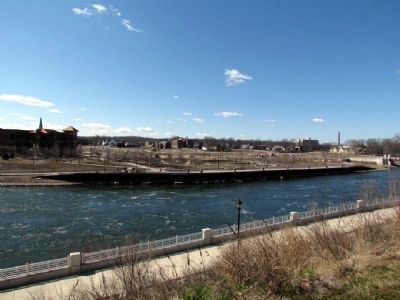Mishawaka in St. Joseph County, Indiana — The American Midwest (Great Lakes)
Ball-Band Factory
Introduction
This monument, overlooking the site of the former Ball-Band factory on the south bank of the St. Joseph River, pays tribute to the thousands of men and women who labored there. The swift-flowing waters of the river attracted manufacturing to Mishawaka in the 1830s, beginning with the St. Joseph Iron Works. Manufacturing flourished on this site through the 19th and 20th centuries, with businesses that included Perkins Windmill Company, Mishawaka Woolen Manufacturing Company, United States Rubber Company, and finally Uniroyal. Local citizens referred to the plant as "Ball-Band," because of the world-famous logo on its manufactured footwear.
Ball-Band employed nearly 10,000 workers during World War II. In 1943, women made up more than half the labor force as they worked the "victory shift" during the war. Employment at the factory declined after the war, and was reduced even more significantly with the discontinuation of footwear in 1969. Over time, Uniroyal Plastics Co. sold the factory's other product lines, further decreasing employment and leading to the deterioration of the 58 buildings that once housed nearly 2 million square feet of industrial space. In 1997 the doors of Ball-Band were closed for good. As a result of bankruptcy proceedings, the City acquired the property in 1999 and completed the demolition in 2001, clearing the path for redevelopment.
Footwear
Ball Band's footwear business began in 1886 when Martin Beiger and Adolphus Eberhart invented the All-Knit Boot. The woolen boot was the first to hold its shape without shrinking or stretching. Its red ball insignia on a black band became the company's trademark. Ball-Band later revolutionized the way rubber footwear was cured by developing a vacuum-pressure method of vulcanization that melded the rubber into the fabric of the shoe. Ball-Band produced rubber shoes, boots and tennis shoes including the popular Red Ball Jets.
Coated Fabrics
In 1934 Ball-Band introduced products other than rubber footwear. Among those new products were coated fabrics, produced by fusing fabric with natural and synthetic rubbers. The first coated fabric, Leatherette, was used for clothing. Raincoats also were made at the factory. Later, the plant expanded its production lines to include Vinylite and Naugahyde. These products were used for upholstered furniture, sporting goods, automobile seating, and luggage.
Koylon Foam
In 1937 Ball-Band began producing foam rubber used in automotive cushions, mattresses, office and theater seating, hospital rings and bed padding. Before World War II, the Mishawaka plant used 250 tons of natural latex a month. When foreign sources of natural latex were cut off during the war, researchers developed synthetics from petroleum products. In later years, because of lower raw material cost and greater availability, Koylon automotive cushions were made from urethane foam instead of sponge rubber.
Auto Mats
The auto mat business, which started in 1939, employed nearly 200 workers. Rubber and vinyl auto mats made at the factory were used in vehicles produced by Studebaker, General Motors, Ford Motor Company and Chrysler Corporation. As automotive production around the country increased, so did the orders for auto mats from the Mishawaka plant.
Fuel Cells
Ball-Band joined the war effort in 1941 with the fabrication of self-sealing fuel containers. Rubber fuel cells were superior to metal fuel tanks because they were light, crash resistant and non-corrosive.
They were constructed for B-25 Mitchell twin-engine bombers, B-26 Marauder bombers, and U.S. Navy PT boats. Fuel cells for other military planes, such as the F/A-18 Hornet strike fighter and the B-52 Stratofortress super bomber, were manufactured in later years. Fuel containers for Tomahawk cruise missiles were manufactured as late as the 1990s.
Ensolite and Royalite
Ensolite was made in the factory beginning in the 1950s. This revolutionary flexible foam product, developed with closed-cell inner construction, had unique shock-absorbing, insulating and floating characteristics. During the Korean War, Ensolite was used in boots, jackets and pants worn by the military. Civilian uses included athletic mats, life jackets and padding under artificial turf.
Research and development of Royalite began in 1962. This thermoplastic material was used to make dashboards, canoes and luggage.
Extruded Materials and Adhesives
Heavy rubber extrusions, like tank treads and tug boat fenders, were added in 1958. The same year, the plant began producing industrial adhesives. More than 800 gallons of the product were produced daily the by the 1960s.
Adhesives were also used for construction of fuel cells and other products made at the plant. In later years, roofing adhesives became a significant portion of the business.
Missile Components
The Mishawaka plant began fabricating Minuteman and Polaris missile rocket components in 1959. Uniroyal was a major supplier of case insulation and filament-wound motor cases for these major weapons systems. During peak production, more than $6 million of tooling used to build missile components was in continuous use on all three shifts. Production ceased when motor cases became unnecessary because all missiles were deployed in silo or submarine service.
Topics. This historical marker is listed in this topic list: Industry & Commerce. A significant historical year for this entry is 1943.
Location. 41° 39.948′ N, 86° 10.901′ W. Marker is in Mishawaka, Indiana, in St. Joseph County. Marker can be reached from the intersection of N. Main St and W. Mishawaka Ave. Touch for map. Marker is in this post office area: Mishawaka IN 46544, United States of America. Touch for directions.
Other nearby markers. At least 8 other markers are within walking distance of this marker. Perkins Windmill (approx. 0.2 miles away); Mishawaka Civil War Soldiers Monument (approx. ¼ mile away); First Dam Across The St. Joseph River / Power Race (approx. 0.3 miles away); Mishawaka Fish Ladder (approx. 0.3 miles away); Battell Park (approx. 0.3 miles away); Mishawaka Wars of the Nation Memorial (approx. 0.4 miles away); Kamm & Schellinger Brewery (approx. 0.4 miles away); The Mishawaka Academic and Normal Institute (approx. half a mile away). Touch for a list and map of all markers in Mishawaka.
Credits. This page was last revised on June 16, 2016. It was originally submitted on April 2, 2013, by Duane Hall of Abilene, Texas. This page has been viewed 1,357 times since then and 129 times this year. Photos: 1, 2, 3, 4, 5, 6. submitted on April 2, 2013, by Duane Hall of Abilene, Texas. • Bill Pfingsten was the editor who published this page.
